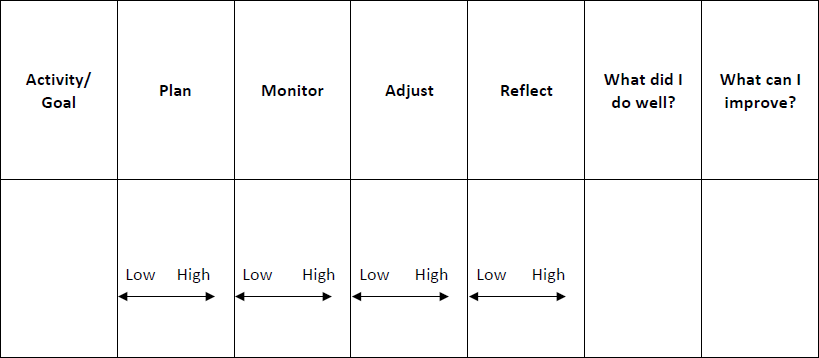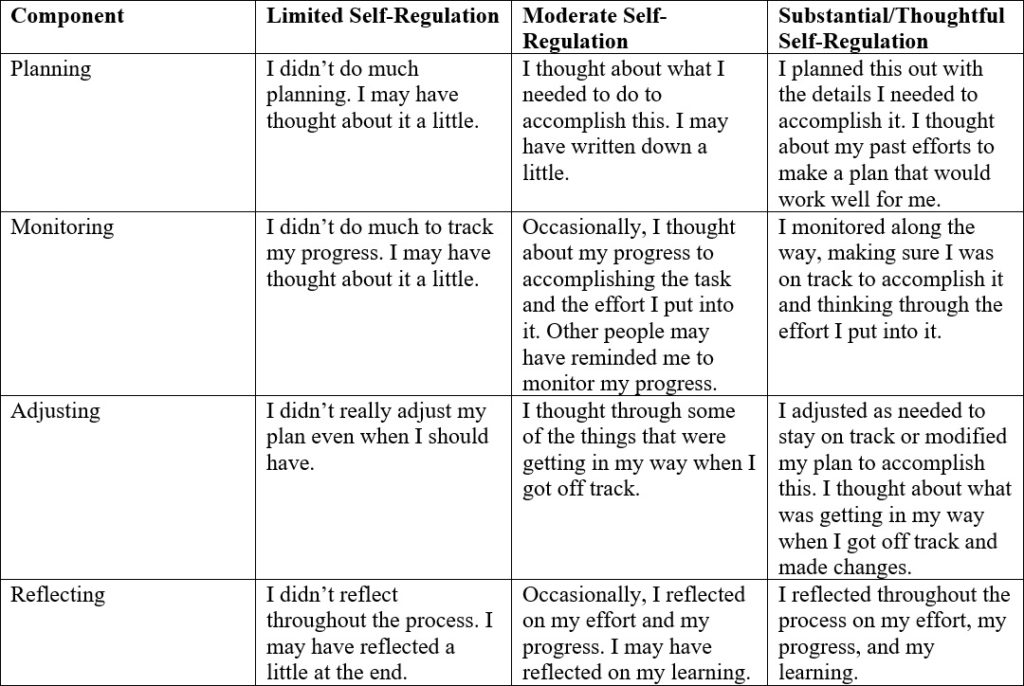Part 1: Teaching Students What Self-Regulation Is and Why It Is Important
Part 2: Helping Students Understand Their Strengths and Challenges in Self-Regulation
- Teach Students: 2a. Evaluating Your Efforts
- The Self-Regulation Knowledge Test
- Creating an Account to Administer the Self-Regulation Knowledge Test
- Teach Students: 2b. Self-Regulation Components
- Teach Students: 2c. Brainstorming Ways to Improve
Part 3: Teaching Students to Plan
Part 4: Embedding Opportunities for Students to Practice Self-Regulation
Part 2: Helping Students Understand Their Strengths and Challenges in Self-Regulation
Learning Target: Students can identify their strengths and challenges related to self-regulation.
In this part, we will explore activities that help students better understand each component of self-regulation and determine which component(s) are areas for personal growth.
Teach Students: 2a. Evaluating Your Efforts
Provide a review of the four components of self-regulation (plan, monitor, adjust, and reflect). Have students write down at least three challenging activities/tasks/goals they’ve been working on recently. These can be related to school, a job, sports/extracurricular activities, or personal lives. Using the identified activities, ask students to draw a mark on the arrow for each component to rate how well they used each component in each situation (even if they weren’t aware they were using the component at the time). Then have students write a sentence or two about what they did well and what they could improve in the future, found on the “Teach Students: 2a. Evaluating Your Efforts” handout (Handout 2a. linked to on page 11 in your Educator Workbook).
Watch an example of a teacher guiding students through this activity.

2a. Reflect and Apply: Think about a task or goal you are currently working toward, personal or professional. Using the chart on page 4 of the Educator Workbook to record your answers, draw a mark on the appropriate arrow for each component while considering the following:
- Do you have a plan for accomplishing your goal?
- What methods are you using to monitor your actions toward reaching the goal?
- Have you made adjustments to your plan?
- Finally, are you reflecting on how things are going as you work toward your goal?
The Self-Regulation Knowledge Test
One way to help students determine their areas of strength and the challenges they face related to self-regulation is to administer the Self-Regulation Knowledge Test (Gaumer Erickson & Noonan, 2022), which is freely available on our website, https://www.cccstudent.org/. The assessment is written at a fifth-grade reading level, and accommodations can include reading the items aloud or explaining the items. It is divided into three sections. The Questionnaire section (Items 1–28) has students rate themselves on a scale from not like me to very like me for each self-regulation behavior described; there are no right or wrong answers in this section. Each item fits within one of the components. Students’ responses in this section are automatically compiled to show which component is their area of strength and which component is more challenging for them. The Knowledge Test (Items 29–48) assesses students’ knowledge of self-regulation concepts with true/false and multiple-choice items. There are correct answers for each of these items, and they are automatically scored when the assessment is submitted. Finally, the Essay (short answer) section (Item 49) asks students to respond to a scenario and will need to be scored by a teacher.
The questionnaire helps students recognize which self-regulation components are areas of strength and which components are more of a challenge. In addition, the knowledge assessment can determine their knowledge of self-regulation concepts, which is often more limited than students anticipate. This awareness can help with gaining student buy-in for learning. For more information on utilizing the Self-Regulation Knowledge Test to measure students’ growth in self-regulation, see the Self-Regulation Assessment Suite: Technical Report (Gaumer Erickson & Noonan, 2022).
Creating an Account to Administer the Self-Regulation Knowledge Test
To administer the Self-Regulation Knowledge Test to students, educators create an account on https://www.cccstudent.org/, a free assessment site (students do not need accounts). Once you have given the Self-Regulation Knowledge Test, you can view and analyze classroom and individual student results on this site. The assessment results can help refine instruction, and students and educators can use the results to show growth in knowledge of self-regulation. Additional details for launching an assessment and reviewing the results are provided on the website.
Teach Students: 2b. Self-Regulation Components
Explain that we all have strengths and areas to improve regarding self-regulation. Ask students to think about the self-regulation components, reflecting on their strengths and areas for improvement. Then associate the four corners of the room with each of the components listed on the poster (e.g., the northwest corner is planning; the southwest corner is monitoring), and have each student stand in the corner representing the component that is their strength. Staying in the corner, have students discuss why they chose the component as their strength. Next, ask groups to share some of what they do that indicates the component is a strength. Summarize the discussion by highlighting commonalities and differences across the groups. This activity was demonstrated in the classroom video provided earlier.
2b. Reflect and Apply: Take a few minutes to review the Self-Regulation Performance-Based Reflection tool (found on page 15 of the Technical Guide). This tool asks students to reflect on their application of each self-regulation component related to a specific assignment, task, or goal.

Considering your classroom activities, when could you ask students to use the reflection tool to improve their practice of self-regulation? Jot down your thoughts on page 4 of the Educator Workbook.
Teach Students: 2c. Brainstorming Ways to Improve
In this activity, students identify specific actions that can be used to address each component. Assign students to small groups. Have students discuss what each component means and what actions/behaviors they could use to address each component. Examples are provided below. After discussing each component, prompt students to individually write 2–3 things that they could do to improve their self-regulation skills within each of the four components on the “Teach Students: 2c. Brainstorming Ways to Improve” handout (Handout 2c. linked to on page 11 of your Educator Workbook).
Example actions or behaviors associated with Component 1 (making a plan) include:
- breaking down big projects/tasks/goals/activities into the smaller pieces that need to be done to reach the desired outcome;
- considering what I need to get done (school and personal tasks/responsibilities) before doing something fun;
- creating a study plan for major tests or a timeline of tasks/steps for long-term projects;
- making detailed plans to reach my goals, including identifying specific things that will help me succeed (e.g., setting aside a particular time each day, providing regular updates to an accountability partner); and
- identifying situations in which I am frequently anxious or frustrated and determining strategies to try in future situations, such as taking deep breaths, waiting to respond until I’ve calmed down, and envisioning a desirable outcome.
Example actions or behaviors associated with Component 2 (monitoring your plan) include:
- identifying and using specific ways to measure my progress toward reaching a goal/completing a task (e.g., keeping and reviewing a journal of my efforts, using a calendar to note smaller task deadlines and track my progress on them);
- taking time each day to identify specific things I need to accomplish and tracking what gets done that day;
- staying aware of my grades, including regularly considering how my recent effort in class has affected them, keeping in mind how my effort on upcoming assignments will also affect my grades; and
- using a calming strategy, keeping track of the number of minutes I practiced, or of my heart rate during exercise.
Example actions or behaviors associated with Component 3 (adjusting your plan as needed) include:
- recognizing when something isn’t working and immediately adjusting my plans/behaviors/actions to try to get back on track;
- being persistent and looking for solutions (and trying as many as necessary) until I succeed instead of just giving up when I get behind in my work or am struggling with something;
- making choices that help me achieve, even when I know other alternatives would be more fun at the moment (but wouldn’t ultimately help me succeed); and
- doing what it takes to accomplish my goals or get my homework done on time (e.g., asking for help on challenging assignments, finding effective ways to maintain my focus on long-term projects).
Example actions or behaviors associated with Component 4 (reflecting on what worked and what to improve) include:
- taking time each day to think about what is working well within my self-regulation efforts, what setbacks I’ve encountered, how I’m going to work past those challenges, and the specific things I’ve learned or progress I’ve made in working on my goal/task;
- thinking about my past efforts when setting new goals (e.g., considering what I did well, what I could change this time);
- talking with a friend, teacher, or family member about my self-regulation efforts, whether I was able to complete the task/achieve my goal, what parts of my plan worked well, and what I want to change next time to make it work better; and
- pausing to consider if I’m effectively self-regulating (e.g., entirely doing all four components). Whether I can see a connection between my self-regulation efforts’ effectiveness (or ineffectiveness) and my overall progress toward my goal.
2c. Reflect and Apply: Refer back to your identified task in the reflective questions for “Teach Students: 2a. Evaluating Your Efforts,” where you rated yourself on how well you were addressing each component. What actions could you take to improve your use of each component? Jot your ideas down on page 5 of the Educator Workbook and consider sharing your example with your students.

